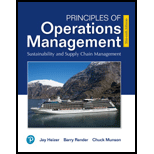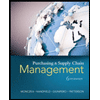
Concept explainers
a)
To determine: The multifactor productivity for last year.
Introduction: Multifactor productivity is an evaluation of economic performance that compares the amount of products and services produced to the amount of combined inputs used to produce those products and services.
a)
Answer to Problem 17P
Hence, the multifactor productivity for last year is 0.8533.
Explanation of Solution
Given information:
The given information is as follows:
| Last year | This year | |
| Production (dozen) | 1,500 | 1,500 |
| Labor (hours) | 350 | 325 |
| Capital investment ($) | 15,000 | 18,000 |
| Energy (BTU) | 3,000 | 2,700 |
Labor cost is given as $8 per hour, capital is 0.83% per month of investment, and energy is $0.60 per BTU.
Formulae to determine the multifactor productivity:
Determine the multifactor productivity for last year:
It is calculated by dividing the output units and the value attained by adding the multiple of labor hours and cost per hours, sum of capital investment and interest on capital, and multiple of energy and rate.
Hence, the multifactor productivity for last year is 0.8533.
b)
To determine: The multifactor productivity for the current year.
Introduction: Multifactor productivity is an evaluation of economic performance that compares the amount of products and services produced to the amount of combined inputs used to produce those products and services.
b)
Answer to Problem 17P
Hence, the multifactor productivity for this year is 0.7496.
Explanation of Solution
Given information:
The given information is as follows:
| Last year | This year | |
| Production (dozen) | 1,500 | 1,500 |
| Labor (hours) | 350 | 325 |
| Capital investment ($) | 15,000 | 18,000 |
| Energy (BTU) | 3,000 | 2,700 |
Labor cost is given as $8 per hour, capital is 0.83% per month of investment, and energy is $0.60 per BTU.
Formulae to determine the multifactor productivity:
Determine the multifactor productivity for this year:
It is calculated by dividing the output units and the value attained by adding the multiple of labor hours and cost per hours, sum of capital investment and interest on capital, and multiple of energy and rate.
Hence, the multifactor productivity for this year is 0.7496.
c)
To determine: The percentage change in productivity for the monthly average last year versus the monthly average this year.
Introduction: Productivity is a measure of the effectiveness of an individual, systems, machinery and other equipment that are used in converting inputs into outputs. In all organizations, productivity is an important determinant to know cost efficiency.
c)
Answer to Problem 17P
Hence, the percent change in multifactor productivity last year versus this year is -11.764.
Explanation of Solution
Given information:
The given information is as follows:
| Last year | This year | |
| Production (dozen) | 1,500 | 1,500 |
| Labor (hours) | 350 | 325 |
| Capital investment ($) | 15,000 | 18,000 |
| Energy (BTU) | 3,000 | 2,700 |
Labor cost is given as $8 per hour, capital is 0.83% per month of investment, and energy is $0.60 per BTU.
Formulae to calculate the percentage change on multifactor basis:
Calculate the percentage change on multifactor basis:
It is calculated by the dividing the value attained by subtracting the multifactor productivity last year from last year from this year and the multifactor productivity last year.
Hence, the percentage change on multifactor basis is -12.15%.
Want to see more full solutions like this?
Chapter 1 Solutions
EBK PRINCIPLES OF OPERATIONS MANAGEMENT
- Prepare a graph of the monthly forecasts and average forecast demand for Chicago Paint Corp., a manufacturer of specialized paint for artists. Compute the demand per day for each month (round your responses to one decimal place). Month B Production Days Demand Forecast Demand per Day January 21 950 February 19 1,150 March 21 1,150 April 20 1,250 May 23 1,200 June 22 1,000' July 20 1,350 August 21 1,250 September 21 1,050 October 21 1,050 November 21 December 225 950 19 850arrow_forwardThe president of Hill Enterprises, Terri Hill, projects the firm's aggregate demand requirements over the next 8 months as follows: 2,300 January 1,500 May February 1,700 June 2,100 March April 1,700 1,700 July August 1,900 1,500 Her operations manager is considering a new plan, which begins in January with 200 units of inventory on hand. Stockout cost of lost sales is $125 per unit. Inventory holding cost is $25 per unit per month. Ignore any idle-time costs. The plan is called plan C. Plan C: Keep a stable workforce by maintaining a constant production rate equal to the average gross requirements excluding initial inventory and allow varying inventory levels. Conduct your analysis for January through August. The average monthly demand requirement = units. (Enter your response as a whole number.) In order to arrive at the costs, first compute the ending inventory and stockout units for each month by filling in the table below (enter your responses as whole numbers). Ending E Period…arrow_forwardMention four early warning indicators that a business may be at risk.arrow_forward
- 1. Define risk management and explain its importance in a small business. 2. Describe three types of risks commonly faced by entrepreneurs. 3. Explain the purpose of a risk register. 4. List and briefly describe four risk response strategies. (5 marks) (6 marks) (4 marks) (8 marks) 5. Explain how social media can pose a risk to small businesses. (5 marks) 6. Identify and describe any four hazard-based risks. (8 marks) 7. Mention four early warning indicators that a business may be at risk. (4 marks)arrow_forwardState whether each of the following statements is TRUE or FALSE. 1. Risk management involves identifying, analysing, and mitigating risks. 2. Hazard risks include interest rate fluctuations. 3. Entrepreneurs should avoid all forms of risks. 4. SWOT analysis is a tool for risk identification. 5. Scenario building helps visualise risk responses. 6. Risk appetite defines how much risk an organisation is willing to accept. 7. Diversification is a risk reduction strategy. 8. A risk management framework must align with business goals. 9. Political risk is only relevant in unstable countries. 10. All risks can be eliminated through insurance.arrow_forward9. A hazard-based risk includes A. Political instability B. Ergonomic issues C. Market demand D. Taxation changesarrow_forward
 Purchasing and Supply Chain ManagementOperations ManagementISBN:9781285869681Author:Robert M. Monczka, Robert B. Handfield, Larry C. Giunipero, James L. PattersonPublisher:Cengage LearningMarketingMarketingISBN:9780357033791Author:Pride, William MPublisher:South Western Educational Publishing
Purchasing and Supply Chain ManagementOperations ManagementISBN:9781285869681Author:Robert M. Monczka, Robert B. Handfield, Larry C. Giunipero, James L. PattersonPublisher:Cengage LearningMarketingMarketingISBN:9780357033791Author:Pride, William MPublisher:South Western Educational Publishing Contemporary MarketingMarketingISBN:9780357033777Author:Louis E. Boone, David L. KurtzPublisher:Cengage Learning
Contemporary MarketingMarketingISBN:9780357033777Author:Louis E. Boone, David L. KurtzPublisher:Cengage Learning Management, Loose-Leaf VersionManagementISBN:9781305969308Author:Richard L. DaftPublisher:South-Western College Pub
Management, Loose-Leaf VersionManagementISBN:9781305969308Author:Richard L. DaftPublisher:South-Western College Pub





